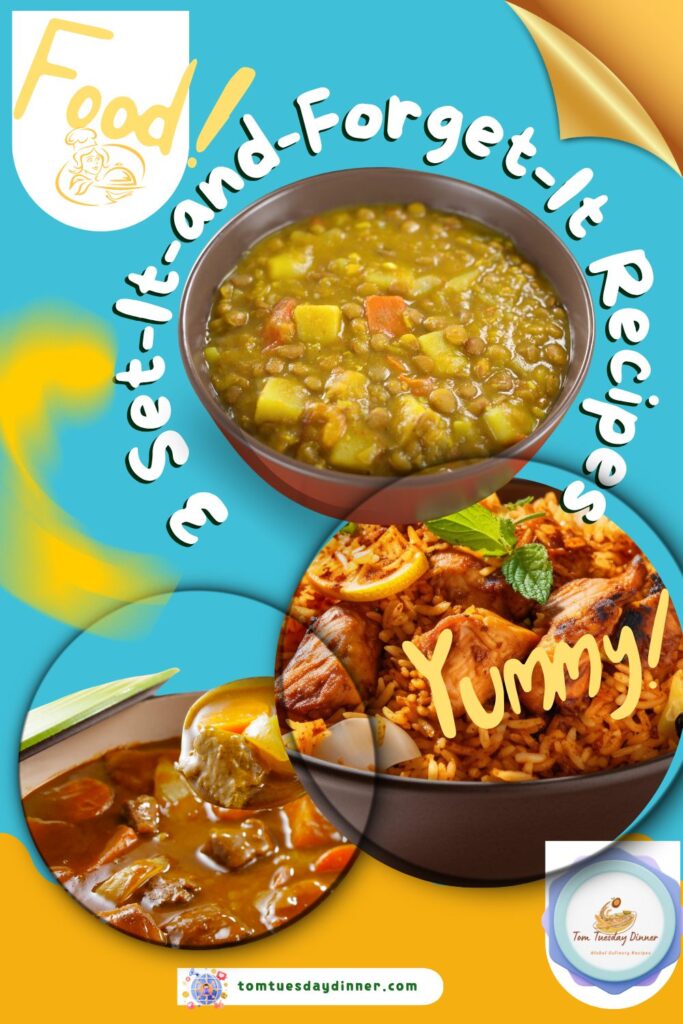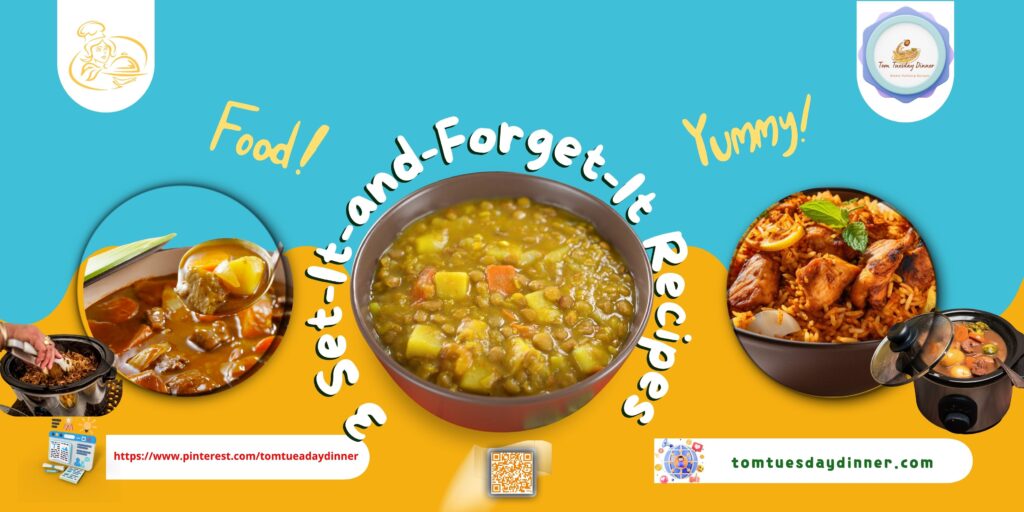We use affiliate links. If you purchase something using one of these links, we may receive compensation or commission.

There’s something almost mystical about coming home to the rich, welcoming aroma of a meal that’s been quietly perfecting itself all day. If you’ve ever wondered whether slow cookers truly live up to their reputation as kitchen game-changers, you might be pleasantly surprised by what these humble appliances can accomplish.
In our fast-paced world, the slow cooker seems to offer a gentle rebellion against rushed meals and takeout fatigue. But does it really deliver on its promise of effortless, delicious cooking? Let’s explore three carefully selected recipes that might just transform your relationship with weeknight dinners.
Why Slow Cookers Are Your Kitchen’s Best Friend
You’ve probably heard the claims before – throw some ingredients into a pot, set it, and forget it until dinner time. While this sounds almost too good to be true, slow cookers have been quietly revolutionizing home cooking for decades, and there might be good reasons for their enduring popularity.
The Science Behind Slow Cooking
The magic of slow cooking lies in its gentle, consistent heat application. When you cook at low temperatures for extended periods, tough proteins break down gradually, creating incredibly tender results that might be difficult to achieve through conventional cooking methods. This process, called collagen breakdown, transforms even the most challenging cuts of meat into fork-tender perfection.
The enclosed environment also creates a unique cooking atmosphere where flavors meld and intensify over time. Unlike stovetop cooking where liquid evaporates quickly, slow cookers trap moisture and allow ingredients to essentially braise in their own juices.
Benefits That Might Just Change Your Life
Beyond the obvious convenience factor, slow cookers offer several advantages that could make them valuable additions to your kitchen arsenal. They typically use less energy than conventional ovens, potentially reducing your utility bills. The low-temperature cooking method also helps preserve nutrients that might be lost through high-heat cooking methods.
For busy families, the psychological benefits might be equally important. There’s genuine peace of mind in knowing dinner is handled, especially during those hectic weekdays when time seems to slip away faster than you’d like.
Essential Tips for Slow Cooker Success
Before diving into our featured recipes, understanding a few fundamental principles could make the difference between mediocre and memorable results. Slow cooking might seem foolproof, but a little knowledge goes a long way.
Choosing the Right Size and Model
The size of your slow cooker matters more than you might initially think. A 6-quart model typically works well for families of four to six, while smaller households might find 3-4 quart models more practical. Cooking in a too-large slow cooker can lead to faster liquid evaporation and potentially overcooked edges.
Modern slow cookers often feature programmable timers and automatic warming functions, which can be genuinely helpful for longer cooking times. However, basic models without these features can work just as effectively for most recipes.
Preparation Techniques That Make a Difference
While slow cookers are forgiving, certain preparation steps can significantly improve your results. Browning meats before adding them to the slow cooker isn’t always necessary, but it can add depth of flavor that you might appreciate in the final dish.
Layering Ingredients for Optimal Results
The order in which you add ingredients can affect cooking times and final textures. Root vegetables like potatoes and carrots typically take longer to cook than meat, so placing them at the bottom where they’ll be closest to the heat source makes sense.
When to Add Dairy and Delicate Ingredients
Dairy products, fresh herbs, and delicate vegetables often benefit from being added during the final 30-60 minutes of cooking. This prevents curdling in dairy products and helps maintain the bright flavors and textures of more delicate ingredients.
Recipe #1: Hearty Beef Stew That Practically Cooks Itself
This might become your go-to comfort food recipe, especially during cooler months when you’re craving something substantial and warming. The combination of tender beef, hearty vegetables, and rich broth creates a meal that feels like a warm hug from the inside out.
Ingredients You’ll Need
- 2 pounds beef chuck roast, cut into 2-inch cubes
- 4 medium potatoes, peeled and quartered
- 3 large carrots, cut into 2-inch pieces
- 1 large onion, roughly chopped
- 3 celery stalks, chopped
- 3 cloves garlic, minced
- 2 cups beef broth
- 2 tablespoons tomato paste
- 1 teaspoon dried thyme
- 1 teaspoon dried rosemary
- 2 bay leaves
- Salt and pepper to taste
- 2 tablespoons cornstarch mixed with 2 tablespoons cold water (optional, for thickening)
Step-by-Step Instructions
Begin by seasoning your beef cubes generously with salt and pepper. If you have time, browning the beef in a skillet before adding it to the slow cooker can add extra flavor, though this step isn’t absolutely necessary.
Layer the potatoes and carrots in the bottom of your slow cooker, followed by the onion, celery, and garlic. Place the seasoned beef on top of the vegetables. In a small bowl, whisk together the beef broth, tomato paste, thyme, rosemary, and bay leaves, then pour this mixture over everything in the slow cooker.
Cook on low for 7-8 hours or high for 4-5 hours, until the beef is fork-tender and the vegetables are cooked through. If you prefer a thicker stew, you can stir in the cornstarch mixture during the last 30 minutes of cooking.
Pro Tips for Perfect Beef Stew
Resist the urge to lift the lid frequently during cooking – each peek can add 15-20 minutes to your cooking time. The beef should be tender enough to shred with a fork when it’s properly done. If your stew seems too thin, leaving the lid slightly ajar during the last hour can help reduce excess liquid.
Recipe #2: Tender Chicken and Rice One-Pot Wonder
This recipe might solve your “what’s for dinner?” dilemma more often than you’d expect. It’s particularly appealing because it produces a complete meal in one pot, meaning fewer dishes to wash and more time for the things you actually enjoy doing.
Why This Recipe Might Become Your Go-To
The beauty of this dish lies in its versatility and simplicity. You can easily customize it with different vegetables, spices, or even switch the protein if you prefer. It’s also budget-friendly, using affordable ingredients that you might already have in your pantry.
Ingredients and Instructions
- 4-6 boneless, skinless chicken thighs
- 1½ cups long-grain white rice (uncooked)
- 2½ cups chicken broth
- 1 packet onion soup mix
- 1 bag (16 oz) frozen mixed vegetables
- 1 can (10.75 oz) cream of mushroom soup
- ½ cup shredded cheese (optional)
- Salt and pepper to taste
Start by placing the chicken thighs in the bottom of your slow cooker and seasoning them with salt and pepper. In a separate bowl, combine the rice, chicken broth, onion soup mix, and cream of mushroom soup, stirring until well mixed.
Pour this mixture over the chicken, then add the frozen vegetables on top. Don’t stir – the layering is important for even cooking. Cook on low for 4-5 hours or until the chicken is cooked through and the rice is tender.
If using cheese, sprinkle it over the top during the last 15 minutes of cooking. Let the dish rest for 5-10 minutes before serving to allow the flavors to settle.
Customization Ideas to Suit Your Taste
You might want to experiment with different soup mixes or add your favorite seasonings. Italian seasoning, garlic powder, or even a touch of curry powder can create completely different flavor profiles. Fresh herbs added at the end can brighten the entire dish.
Recipe #3: Vegetarian Lentil Curry for Plant-Based Perfection
For those exploring plant-based options or simply wanting to incorporate more vegetables into their diet, this lentil curry might surprise you with its rich, satisfying flavors. It’s proof that vegetarian slow cooker meals can be just as hearty and fulfilling as their meat-based counterparts.
The Magic of Slow-Cooked Lentils
Lentils are particularly well-suited to slow cooking because they absorb flavors beautifully while maintaining their texture. Unlike some legumes that require pre-soaking, lentils cook perfectly from their dried state, making this recipe genuinely convenient.
Complete Recipe Guide
- 1½ cups dried red lentils, rinsed
- 1 large onion, diced
- 3 cloves garlic, minced
- 1 tablespoon fresh ginger, minced
- 1 can (14 oz) diced tomatoes
- 1 can (14 oz) coconut milk
- 2 cups vegetable broth
- 2 tablespoons curry powder
- 1 teaspoon turmeric
- 1 teaspoon cumin
- ½ teaspoon cayenne pepper (adjust to taste)
- 2 cups baby spinach
- Salt to taste
- Fresh cilantro for garnish
Combine the lentils, onion, garlic, ginger, diced tomatoes, coconut milk, vegetable broth, and all spices in your slow cooker. Stir well to ensure the spices are evenly distributed.
Cook on low for 6-7 hours or high for 3-4 hours, until the lentils are tender and the curry has thickened. During the last 30 minutes of cooking, stir in the baby spinach and let it wilt into the curry.
Taste and adjust seasoning as needed. The curry should be creamy and well-spiced, but not overwhelming. Serve over rice or with naan bread, and garnish with fresh cilantro.
Serving Suggestions and Storage Tips
This curry actually improves in flavor after a day or two, making it perfect for meal prep. It freezes well for up to three months, and you can easily double the recipe if you want to batch cook. Consider serving it with a dollop of plain yogurt to balance the spices, or add a squeeze of fresh lime juice for brightness.
Common Slow Cooker Mistakes to Avoid
Even with the most forgiving cooking method, certain mistakes can lead to disappointing results. Understanding these potential pitfalls might save you from culinary frustration and help you get the most from your slow cooker investment.
Overcrowding and Liquid Levels
One of the most common errors is filling the slow cooker too full or adding too much liquid. Most slow cookers work best when filled between half and two-thirds full. Overfilling can lead to uneven cooking and potentially dangerous spillover.
Regarding liquid, remember that slow cookers don’t allow much evaporation, so you typically need less liquid than you might use for stovetop cooking. Most vegetables release moisture during cooking, which can dilute your flavors if you’re not careful.
Temperature and Timing Considerations
While slow cookers are designed to be forgiving, dramatically extending cooking times can lead to mushy vegetables and overcooked proteins. Conversely, not allowing enough time can leave you with tough meat and undercooked vegetables.
The “warm” setting on your slow cooker is designed for keeping food at serving temperature, not for cooking. Using it for extended periods might not maintain safe food temperatures, particularly for dishes containing meat or dairy.
Conclusion
Slow cookers might not be magical in the literal sense, but they do offer something close to kitchen wizardry for busy home cooks. These three recipes represent just a starting point for your slow cooking journey – each one designed to build your confidence while delivering genuinely satisfying meals.
The beauty of slow cooking lies not just in its convenience, but in the way it encourages a more relaxed approach to meal preparation. In a world that often feels rushed and chaotic, there’s something deeply satisfying about knowing that dinner is quietly taking care of itself while you focus on other aspects of your day.
Whether you’re a slow cooking novice or someone looking to expand your repertoire, these recipes offer a foundation for countless variations and experiments. The key is to start simple, understand the basic principles, and then let your creativity guide you toward the flavors and combinations that appeal most to your family’s tastes.


